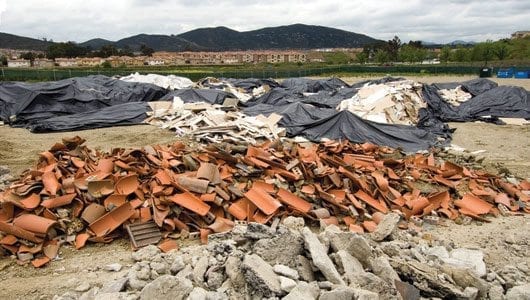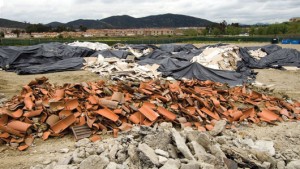
Waste management on jobsites

Recycling containers should be as convenient to use as trash. Bins should be centrally located and easily accessible.
A new force is driving contractors to employ waste management on jobsites and recycle the waste they generate.
“We have been pushing our clients for 30 years, and now they are pushing us,” says John Abrams, president of South Mountain, a design/build firm in West Tisbury, Massachusetts.
At the same time, communities across the country are passing ordinances that require recovery of construction and demolition (C&D) materials. For example, Chicago requires 50 percent of recyclable C&D materials be recycled, and the state of Wisconsin has enacted similar legislation.
Contractors who are recycling and reusing construction waste are finding another benefit: the cost savings. “High tipping fees have an impact on disposal economics and make recycling a more attractive option,” says Tisha Petteway, spokesperson for the Environmental Protection Agency.
“Disposal is getting to be so expensive that all of us are going to have to recycle eventually,” says Abrams. “It’s only a question of when.”
According to Marianne Bithell, project management assistant for Pacific Builders, based in Arcata, California, the company was able to recycle or reuse 64 percent of its waste during a recent 12-month period — saving more than $37,000. More than 298 tons of wood, concrete, asphalt, brick, cardboard, plastic sheeting, green waste, metal scrap and reusable fixtures were recycled or reused.
“We used everything from materials-processing centers, local recycling centers and salvage operations to Web sites, co-generation plants, and non-profits,” says Bithell. Pacific Builders was recently recognized for its waste reduction efforts by the California Integrated Waste Management Board.
Black Mountain Ranch, developer of the award-winning Del Sur, a 3,050-home master-planned community in San Diego, initiated a mandatory recycling program on the project that diverted 92 percent of waste and saved more than $217,000. The recycling plan included a 4-acre on-site recycling facility that was built to collect and process waste materials. Much of that processed material was later used in the project: Shredded lumber was used as landscaping mulch, excess concrete was crushed for road base and waste drywall was added to the soil.

To begin a recycling program, start with materials that are easiest to recycle locally: wood, metal and concrete.
Recycling strategies
“One of the main barriers to recycling is not having done it before,” says Jenna Kunde, executive director of WasteCap Wisconsin, a state-wide industry-supported nonprofit organization. WasteCap trains contractors how to reduce waste and recycle. According to Kunde, once contractors realize it is not that difficult, they are likely to continue. (Later this year, WasteCap will introduce WasteCap TRAC, software designed to track the savings generated by waste reduction.)
“Even though contractors were required to recycle, they still initially resisted the recycling effort at Del Sur,” says Johnny Perkins, director of municipal sales and marketing for Allied Waste Services, the company that managed waste at Del Sur. “Once they became accustomed to recycling, we were amazed at the quantity of material we were able to recover.”
Techniques for reducing waste are as varied as the waste itself. Waste can be separated at the job site or comingled, self-hauled or picked up by a hauler, and even processed at the site. Materials can be reused on the job or donated to a building-material reuse center. Other recyclables, such as cardboard and metal, can be sold.
“There is no best way to recycle,” says Kunde. “It depends on the site, the space, the size of the project and the amount of time the project will take.”
Keys to success
To begin a recycling program, start with materials that are easiest to recycle locally: wood, metal and concrete. Find out if there is a C&D materials reuse and recycling facility nearby. Several Web sites list reuse and recycling facilities, including The Whole Building Design Guide (www.wbdg.org), the Building Materials Reuse Association (www.buildingreuse.org) and the Construction Materials Recycling Association (www.cdrecycling.org).
Then tell laborers, subcontractors and other employees about the company’s commitment to recycling. “Getting buy-in is probably the hardest part,” says Bithell. Kunde recommends writing recycling requirements into contracts so job-site supervisors have the authority to enforce the recycling plan. Knowing waste reduction is being measured also helps encourage recycling.
Purchasing also plays an important role in managing waste. For example, Pacific Builders requires suppliers to return any unused materials. Contractors can request minimal or no packaging from suppliers to reduce packaging waste, check material deliveries to ensure the correct amount of materials is delivered and buy products made from recycled materials.
Reusing materials
On some jobs, materials can be reused. For example, South Mountain uses reclaimed wood for about 90 percent of the exposed interior and exterior wood in the buildings it constructs. At Jenny Way, the company’s low-income housing project in Edgartown, Mass., all the flooring used is from houses that were “deconstructed.”
“When we are faced with a tear down, we don’t tear down,” says Abrams. “We deconstruct.” Materials are then inventoried and designed into new projects. The Jenny Way Project earned a LEED Platinum certification. Programs such as LEED (Leadership in Energy and Environmental Design) provide independent, third-party verification that a building meets the highest green building and performance measures.
As costs for traditional disposal methods increase, and building owners and communities demand green construction practices, the barriers to reducing construction waste are crumbling. Doing what’s right for the environment makes good business sense. And recycling produces another benefit: cleaner, safer sites.
Setting up a recycling center
- Make it convenient — Recycling containers should be as convenient to use as trash. Bins should be centrally located and easily accessible.
- Prevent drive-by dumping — Keep recycling containers out of public view so loads are not contaminated.
- Get buy-in from the crew and subcontractors — Include waste reduction requirements in all bid documents and contracts. Discuss the recycling program at all meetings. Allow time for employees to learn new procedures.
- Communicate — Post signs that clearly designate recycling containers with lists of what is to be put in each.
- Follow-up — Check trash bins for recycled materials and recycle bins for trash.
—By J. Costin

